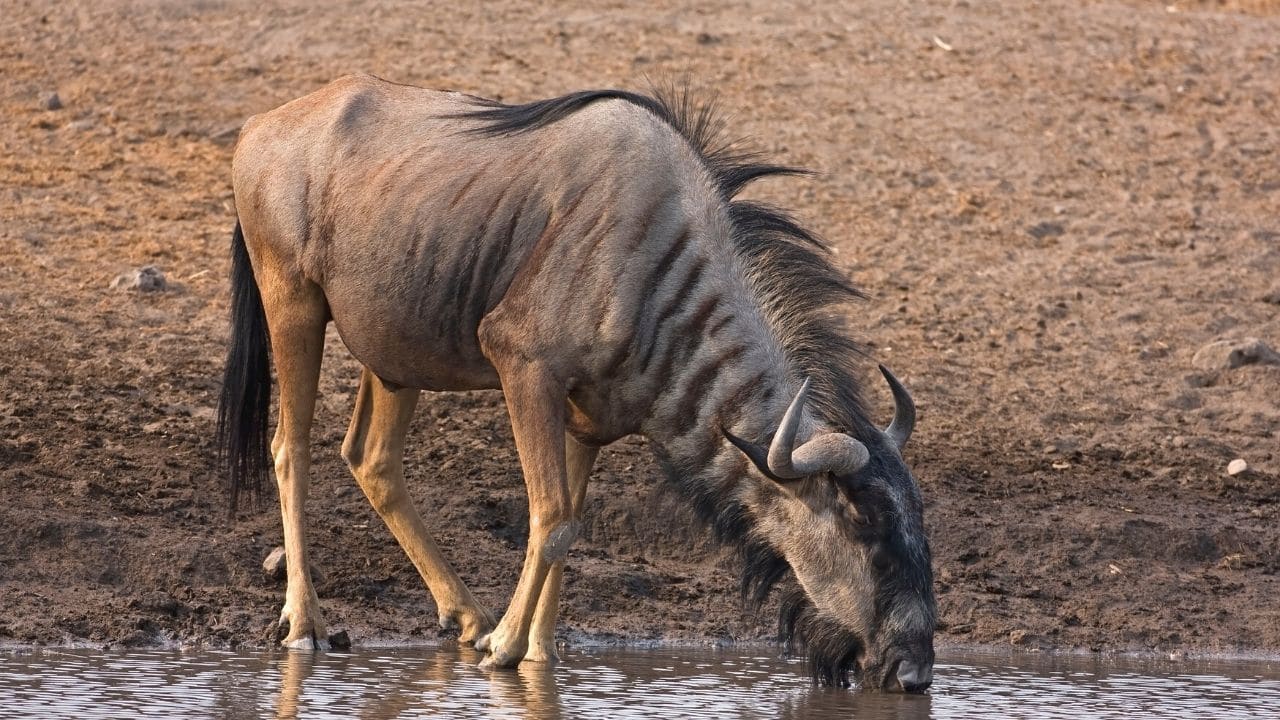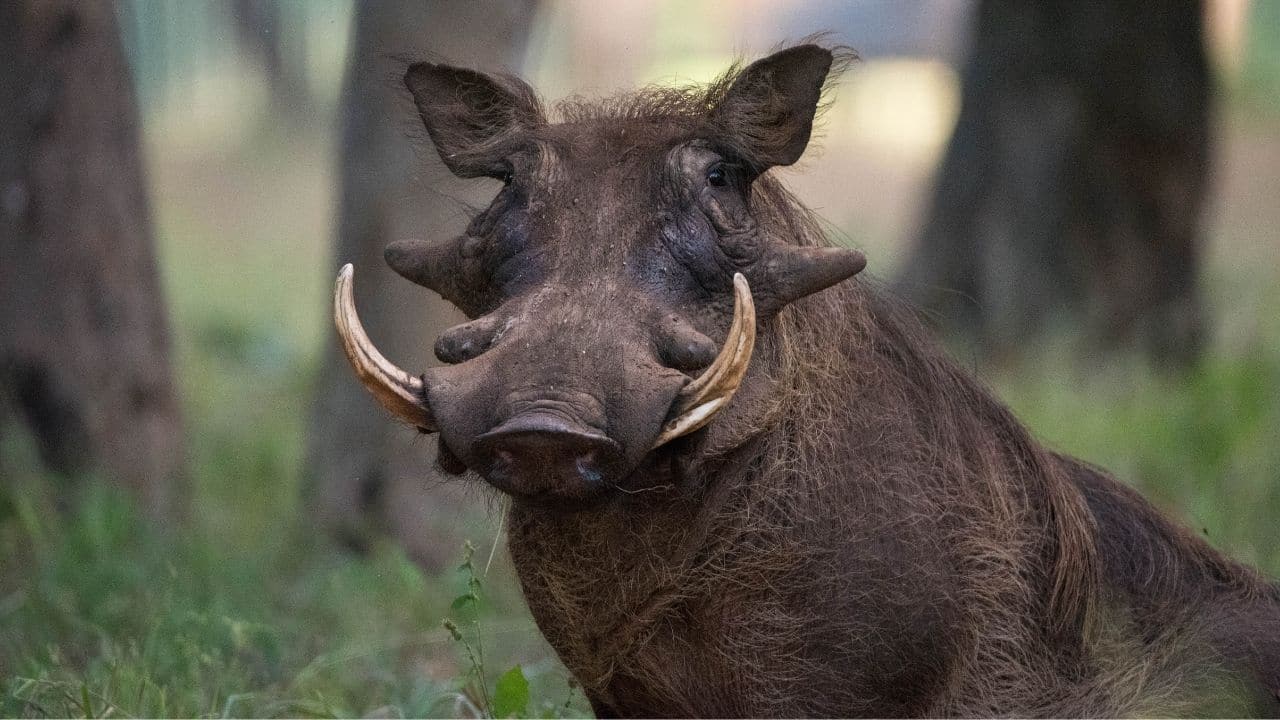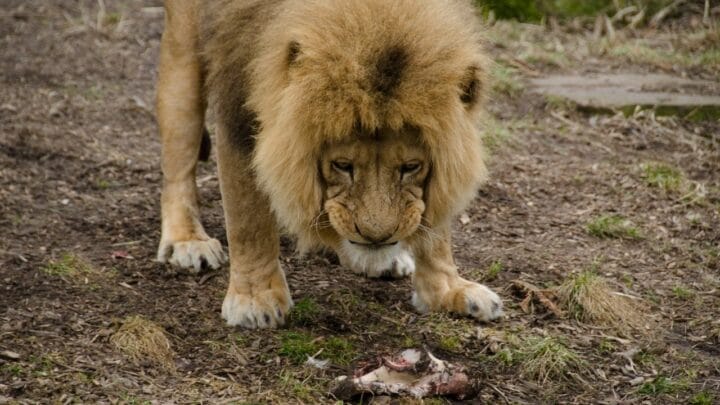‘King of the jungle’. This is what we usually call lions.
Strange, because lions live in areas that are just about completely different from jungles.
Where this title is accurate, though, is that lions are at the top of their food chain.
What animals do lions eat?
Lions are highly efficient predators and can eat just about anything below them on the food chain, including smaller animals like lizards and even mice, and very big animals, including elephants. The animals they hunt most often, though, are antelope and zebra.
Impala

Impalas are one of the most common antelopes in parts of Africa and form an important part of a lion’s diet. They are medium-sized bucks, standing 2.5-3 ft (75-95cm) and are 4.5 ft (1.4 m) long.
Impalas are red-brown in color and the males have curved, vertical horns.
Impalas are grazers, which means that they feed on grass, usually on open grassland, but they are also found among thin tree cover. They live in herds, either a breeding herd or a bachelor herd.
The breeding herd is made up of one dominant male and the females and young. The bachelor herd is made up of young males that have been pushed out by the dominant male.
The breeding herd is what the lions will go after because the females don’t have horns to defend themselves and there may be a young buck to hunt.
When the dominant bull is beaten by a young challenger, he is pushed out of the herd and can also become a target for lions.
Wildebeest

Wildebeest, or gnus, are also an important part of the lions’ diet. They are grey in color and have a shaggy head, with slightly curved, horizontal horns.
Wildebeest stand between 4 and 5 ft (1,3 and 1,5 m) at the shoulder. They are between 5 and 8 ft (1.5 and 2.5 m) long and can weigh 350 – 500 pounds (160 – 250 kg).
A wildebeest can run at about 50 mp/h (80 km/h), which is the top speed of a lion. However, a wildebeest can keep up that speed for much longer than a lion can.
Like other prey animals, wildebeests know that there is safety in numbers and they travel in herds: breeding and bachelor herds.
Lions will usually target the breeding herd, especially the young, but they can also go for a lone gnu, especially if it is older.
Zebra

A zebra looks like a medium-sized horse sporting black and white stripes. They are grazers and are usually found in the savannah, although they may also graze in areas that have some trees and bushes.
Zebras stand 3.5 – 5 ft (1 – 1.5 m) at the shoulder and are about 8 ft (2.4 m) long. They weigh about 900 lbs (400 kg) and can run up to 65 km/hour.
This means that, if a lion is relatively close, it will be able to outrun the zebra. They won’t be able to keep up their speed for long, though, so the zebra can outrun them in distance.
Zebras live in herds, which means that the breeding herds will be targeted by the lions. They can also go after the bachelors, though, especially if the lions are hunting in a group.
Warthog

Warthogs are some of the smaller animals that lions can hunt. They are wild pigs and have sharp, powerful tusks.
These animals are quite small, about 3 – 5 ft (1-1,5 m) long, and are 2 – 3 ft (64-85 cm) at the shoulder. They can weigh 60 – 150 pounds (45- 75 kg).
Warthogs can only run at about 30 mph (48kph), which means that a lion will outrun them easily. They have a different strategy, though: to hide in the ground.
Warthogs live in burrows and will rush into them if they are chased by a lion.
Warthogs are excellent prey for young lions to go after on their first hunts.
Giraffe

In the African savannah, giraffes are the tallest animals you can find. They can stand up to 20 feet (6 m) high.
It can also weigh up to 3000 lbs (1400 kg). Because they are such tall animals, giraffes eat leaves from tall trees and are usually found in areas where there are both grass and trees.
They can also see quite far around them, so should see any predators coming. Lions are excellent at camouflaging themselves and at stalking prey, though.
A giraffe’s top speed is only 37 mph (60km/h), so a lion can quite easily outrun them over a short distance. However, a giraffe can run further than a lion can at its top speed.
They can also kick very hard.
Giraffes live in small family groups, with sometimes only three or four animals together. This means the youngsters cannot be protected by hiding in the herd, so they are attractive to lions.
When they drink, giraffes have to open their legs really wide to balance and are quite ungainly and uncomfortable. This makes them vulnerable to attack.
How Lions Hunt
Lions can run up to 50 mph (80 km/h), but only in short bursts. Most of the antelope they hunt regularly can run as fast, or even faster – and for a lot longer.
This means that lions will not very successful at hunting if they rely on chasing their prey. They use a different strategy.
Firstly, lions just about never hunt alone. Usually, the females will go out as a group and hunt.
Sometimes, two or three males may go after bigger prey, like an elephant. Secondly, lions sneak up on their prey and surprise it, which means that it will not have enough time to run away.
The lions are much more likely to hunt successfully like this.
Conclusion
Lions are at the top of their food chain and can really hunt anything below them. They prefer to eat antelope, though, although they will also sometimes go for a warthog or even a smaller animal like a hare.
If the conditions are terrible, like in a drought, then lions will even attack a large animal, like an elephant. When they are desperate, they will really go after any meat source, even if it means eating another lion.


